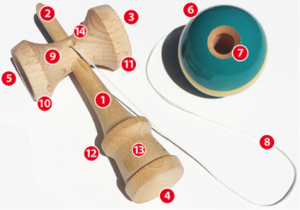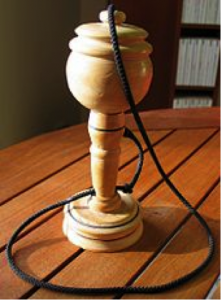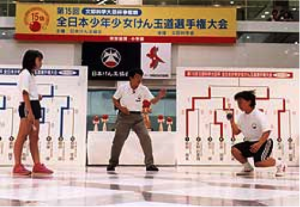About Kendama
Kendama (けん玉, also written as 剣玉 and 拳玉) is a traditional Japanese toy. The ken has three cups and a spike which fits into the hole in the ball. Basic kendama tricks consist of catching the ball in the cups and on the spike. More advanced tricks such as the airplane require you to hold the ball and land the spike in the hole on the ball.
Kendama bears similarities to the classic cup-and-ball game, and the Hispanic world toy known as boliche or balero. The principle of these toys are the same: catching one object with another, where both are joined by a string. However the modern kendama style takes influences from a diverse range of skills including yo-yo, diabolo, juggling and dance.
Structure and terminology
|
History
Origins, precursors, and parallels
A French bilboquet, a relative of the kendama known in France from the 16th century
The origins of the game are obscure. It can be argued that the vagueness of kendama’s origins is due to a common necessity in all hunting cultures for early childhood training of hand-eye co-ordination. It is speculated that the toy may have been invented independently in multiple places, or spread via international commerce.
In Japan
The kendama arrived in Japan via the Silk Road in around 1777, at which point Nagasaki was the only port open to foreign trade.[1] Reportedly, kendama was initially a sort of adult’s drinking game — a player who made a mistake was forced to drink more.[1] The game gained popularity during the Edo Period (1600-1868).[2]
In the early 20th century, the toy had two side cups and was called a jitsugetsu ball (日月ボール?). This translates to ‘sun and moon ball’, named so because of the ball’s representation of the sun and the cups’ likeness to the crescent moon.[3]
In 1919, Hamaji Egusa applied for a patent on the ‘ball and cup’ style toy and it was awarded in 1920. The size and proportions of the toy were later altered. Hatsukaichi City in Hiroshima Prefecture is considered to be the birthplace of the modern Japanese Kendama.[4] The current competition design descends from Issei Fujiwara’s model, which featured string holes in the crosspiece. Little deviation has been made from his basic design, with the exception of the ken becoming more rounded to reduce wood chipping. It was also Fujiwara who established the Japan Kendama Association, which established the rules for play, the grading system now in use, and organised competition. In order to ensure that the toy was suitable for use in competition, the JKA also standardised kendama itself.
Contemporary culture
Today, kendama is popular in many parts of the world. Kendama is particularly well loved in Japan, where national tournaments are held and Japanese employers recognise applicants who have attained the higher dan rankings as “persistent, patient and determined potential employees”.[citation needed]
In recent years[when?] kendama has surged in popularity outside of Japan. In 2006 KendamaUSA and the British Kendama Association were founded [5][6] and began to promote kendama in North America and Europe, particularly throughout the juggling and rollerblading communities. As players worldwide began to put videos online, kendama continued to grow and has branched out forming its own global community.
Robotics
Kendama play has also been used as a measure of accuracy, agility, and learning ability in robotic arms.[7][8]
Rules
To play with a kendama, one holds the toy, and pulls the ball upward so that it may either be caught in one of the cups or land with the hole on the spike. More advanced tricks include sequential balances, juggles, and catches. There are eleven prescribed moves on the kendama trick list for achieving a kyu ranking and several more for a dan ranking. A 10-kyu rating (the lowest beginner grade) is attained by simply catching the ball in the largest cup. A book published by the Japan Kendama Association lists 101 different tricks for the toy and there are supposedly tens of thousands of trick variations. Different stances and grips are required to perform different tricks.
While most people play with kendamas for personal satisfaction, competitions do take place, especially in Japan. Participation in such competitions entails performing lists of tricks in sequence or completing particular tricks repeatedly for as long as possible. Additionally, tricks may be performed head to head with a rival to determine a winner. The first competitor to fail a trick loses.
In the trick moshikame (もしかめ?), the ball is juggled between the big cup and the smallest cup at the bottom repeatedly. A Japanese children’s song of the same name is often sung to help with timing.[9]
Competitions
The Japanese Kendama Association has held kendama contests since 1979.[10]
The British Kendama Association held the first formal kendama contest outside of Japan in 2008 at the British Juggling Convention in Doncaster and has been staging a British Kendama Open and European Kendama Open every year since. These contests have taken a variety of formats including trick ladders, speed battles, freestyle, and the head-to-head world championship style.[11]
The Global Kendama Network (Gloken) held the first Kendama World Cup in 2014 in Hatsukaichi, Japan, utilizing a new format whereby players choose 5 tricks from a list of 100 and attempt to complete tricks within a time limit. These tricks are classified according to difficulty into 10 different levels and the player receives points corresponding to the level of the completed trick i.e. a level 7 trick is worth 7 points and but a more difficult level 10 trick is worth 10 points[12]
References
- “History – Kendama – Virtual Culture – Kids Web Japan – Web Japan”.
- · Dorothy Perkins (1991). Encyclopedia of Japan: Japanese History and Culture, from Abacus to Zori. Facts on File. p. 109. ISBN978-0-8160-1934-2.
- · “What Is Kendama? – Kendama – Virtual Culture – Kids Web Japan – Web Japan”.
- · “Kendama”. J-higa.net.Template:Verify-source
- · “What is a Kendama?”. Kendama USA.
- · “Profile of BKA”.
- · Olivier Sigaud; Jan Peters (4 January 2010). From Motor Learning to Interaction Learning in Robots. Springer Science & Business Media. pp. 219–. ISBN978-3-642-05180-7.
- · Biswa N. Datta (28 July 1999). Applied and Computational Control, Signals, and Circuits. Springer Science & Business Media. pp. 177–. ISBN978-0-8176-3954-9.
- · Look Japan. Look Japan, Limited. 1987. p. 33.
- · “けん玉協会の沿革”.
- · “Kendama World Cup”.
- “Gloken Kendama World Cup”.




